Best Things to do in Ronda, Spain
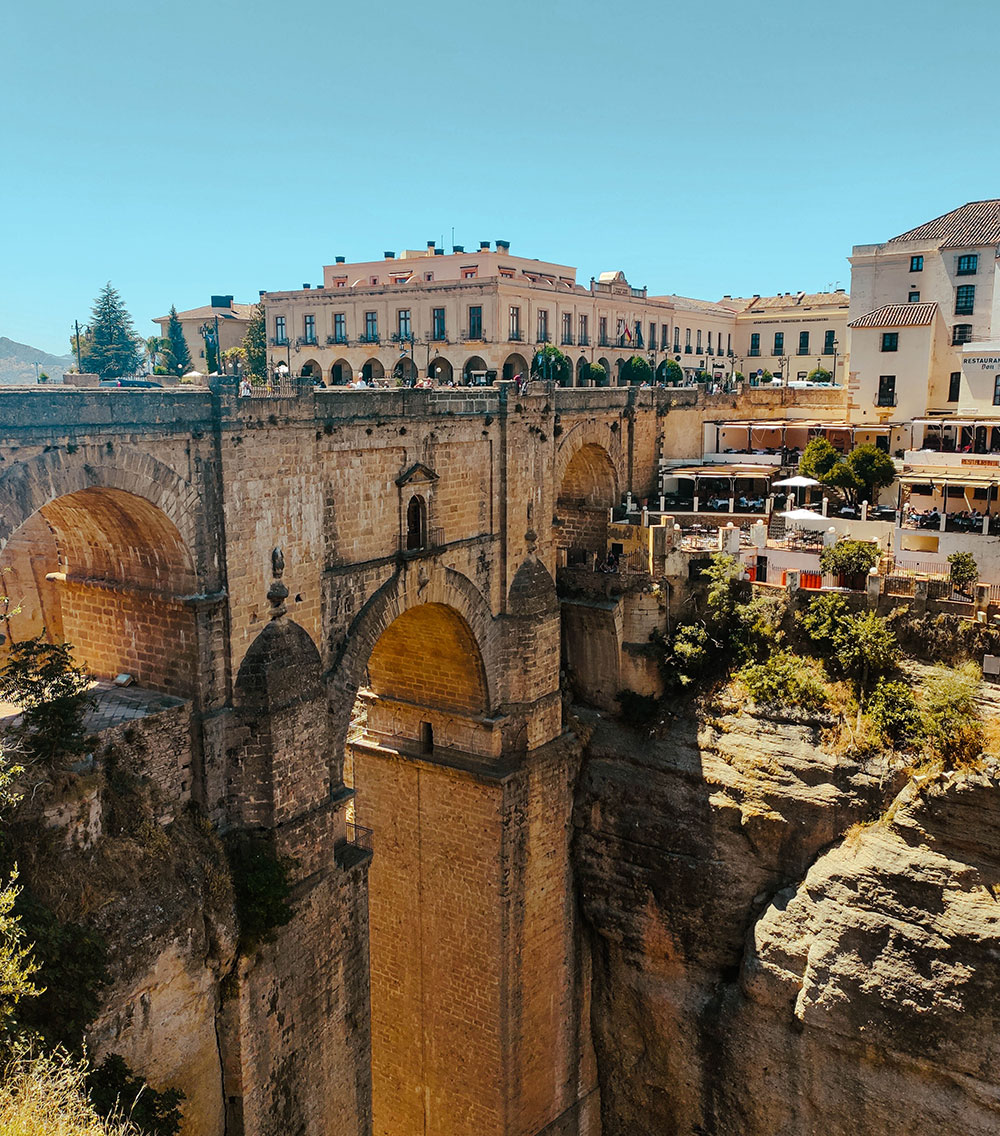
Ronda is a picturesque city located in the Andalusia region of Spain. We visited Ronda in the Summer of 2022 as part of our 4-week road trip in southern and central Spain and 2-week road trip in Andalucia. The city is situated atop the El Tajo Gorge, which is more than 500 feet deep. There are a lot of things to do in Ronda and for that reason, we create a comprehensive guide to this beautiful city.
The village can be visited on foot and a single day is enough to discover all the must-see attractions and points of interest. At the end of the article, you will find our list of suggested itineraries for one two or three days in Ronda!
How to get to Ronda?
Driving to Ronda
Driving is the best way to visit Ronda which is about a 2-hour drive from Seville or Malaga, making it a good option if you are planning a road trip in Andalusia. Specifically, it’s around 105km (1 hour 15 minutes) from Málaga, 130km (1.5 hours) from Seville, and 178km (2 hours) from Granada.
The nearest airport from Ronda is the airport of Malaga but it’s also fairly close to Seville, Jerez, and Gibraltar airports.
Bus to Ronda
Andalusia has several bus companies connecting the cities, towns, and pueblos blancos in the region. There are several buses that run on weekdays, with a reduced schedule on Sundays and holidays. The bus companies operating the route tend to change, so check at the time of your visit to obtain current information.
The bus is the best option if you are on a budget. There are several buses each day from Malaga to Seville / Seville to Malaga, via Ronda. It should only cost around 11 euros and is direct into Ronda, taking just over 2 hours. The bus station is a 10-minute walk from the center of town.
Train to Ronda
There are multiple trains leaving per day but the trains from Seville or Malaga take a long time. You will have to change either at Cordoba, Bobadilla, Antequera Santa Ana, etc and this will cost you more. The train station is a 10-minute walk from the center of town. We don’t suggest you this option – you should better get the bus.
Check out renfe and thetrainline for more information on trains.
Quick Facts
- Location: Andalusia, on a mountaintop, overlooking the El Tajo Gorge.
- Population: the city has a population of around 35,000 people.
- Climate and weather: The city has a Mediterranean climate, with hot summers and mild winters.
- History: Ronda has a rich history, having been settled by the Celts, Romans, and Moors over the centuries.
Best Things to Do in Ronda
Map of Ronda
1. Plaza de Toros de Ronda
The Plaza de Toros de Ronda is a historic bullring that was built in 1785. The bullring can hold up to 5000 spectators and has hosted some of the most famous bullfights in Spain.
You can take a guided tour of the bullring to learn about the history of bullfighting and the significance of the Plaza de Toros de Ronda. The museum inside the bullring is also worth a visit, as it houses a collection of bullfighting memorabilia, including costumes, paintings, and photographs. Only one fight a year is held at the Plaza del Toros now, as part of the Feria de Pedro Romero festival each September.

2. Ronda Viewpoint
To reach the Ronda viewpoint, you can take a short walk from the Plaza de España, or you can drive and park at the nearby parking lot. The viewpoint is open to visitors year-round and is free to enter.
From this viewpoint, you can see the Puente Nuevo, a historic bridge that spans the El Tajo Gorge, as well as the Jardines De Cuenca, a beautiful garden with a stunning view of the valley. You can also take in the beautiful white buildings and winding streets of the old town, and catch a glimpse of the surrounding hills and mountains.
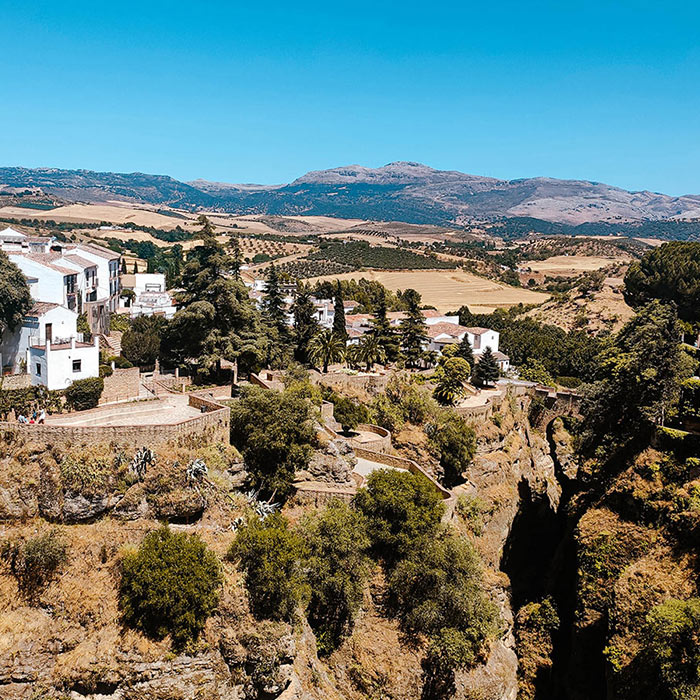
Tours & Tickets ROnda
You can book a guided tour if you want with a local guide. There also organized day tours from Malaga.
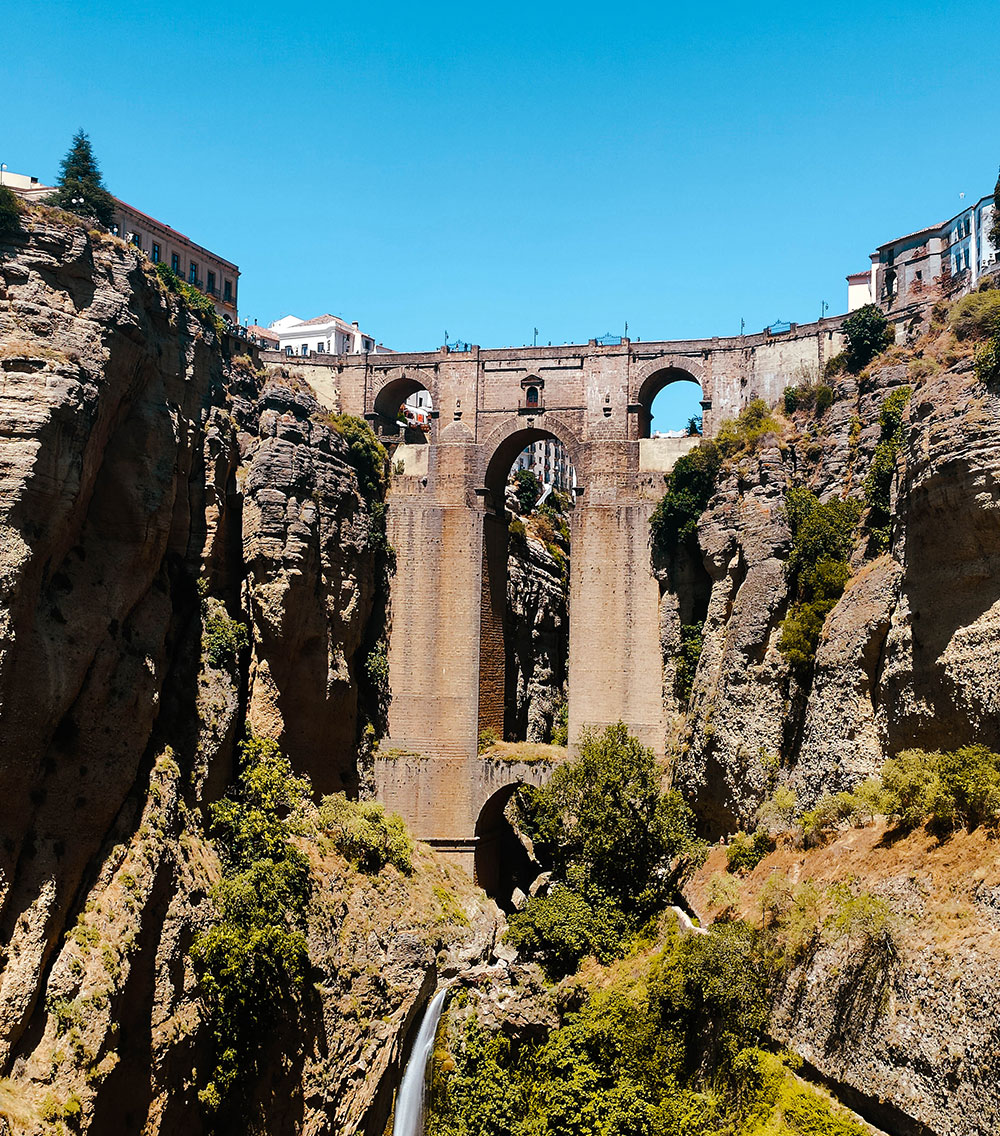
3. The Puento Nuevo
The Puente Nuevo, or “New Bridge,” is one of the most iconic landmarks of Ronda. It spans the El Tajo Gorge and connects the newer, modern part of the city with the historic center. The bridge is accessible by foot from the historic center of Ronda, and there are several parking areas nearby.
While you are there, take a walk across the bridge and enjoy the views of the El Tajo Gorge and the surrounding landscape. The Puente Nuevo is also a popular spot for photographers, especially during sunset when the bridge and the surrounding landscape are bathed in warm, golden light.
The Bridge History
Construction of the bridge began in 1759, but numerous setbacks, including funding issues and the death of the original architect, delayed the project. Finally, in 1793, after over three decades of construction, the bridge was completed. The bridge’s construction required the labor of hundreds of workers and was a remarkable feat of engineering for its time. In addition to serving as a vital link between Ronda’s two parts, the bridge played an important role in the Spanish Civil War, with the Nationalist side reportedly throwing prisoners to their deaths from the bridge. Today, the Puente Nuevo is a beloved symbol of Ronda’s history and an essential stop for visitors to this beautiful Andalusian city.
The Puente Nuevo stands at a height of 120 meters (390 feet) and is made of stone quarried from the nearby mountains. The bridge has three arches, the largest of which spans 42 meters (138 feet) and is the highest of the three.
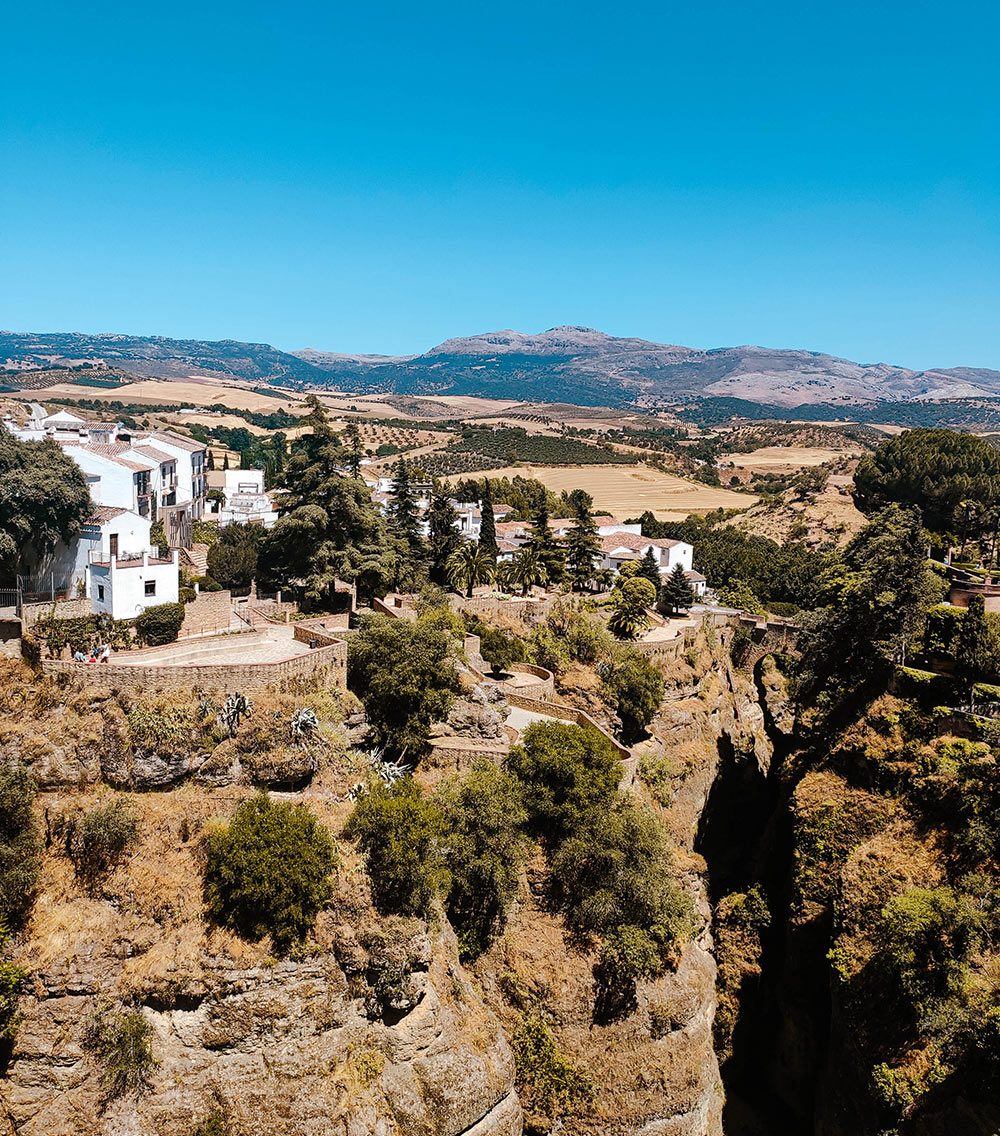
4. Jardines De Cuenca
The Jardines de Cuenca is a beautiful public garden located on the southern edge of Ronda. The gardens were dedicated to Ronda’s twin city Cuenca since both share similarities in their geographical layout. and offer stunning views of the El Tajo gorge and the Puente Nuevo. They are named after the painter Joaquín de Cuenca, who played a key role in designing the park.
The park is well-maintained, with winding paths, fountains, and benches and there are often street performers and musicians entertaining the crowds. You can easily reach the gardens by walking down the Paseo de Blas Infante, which runs along the edge of the gorge.
Opening Times: Every day from 8 AM to 10 PM.
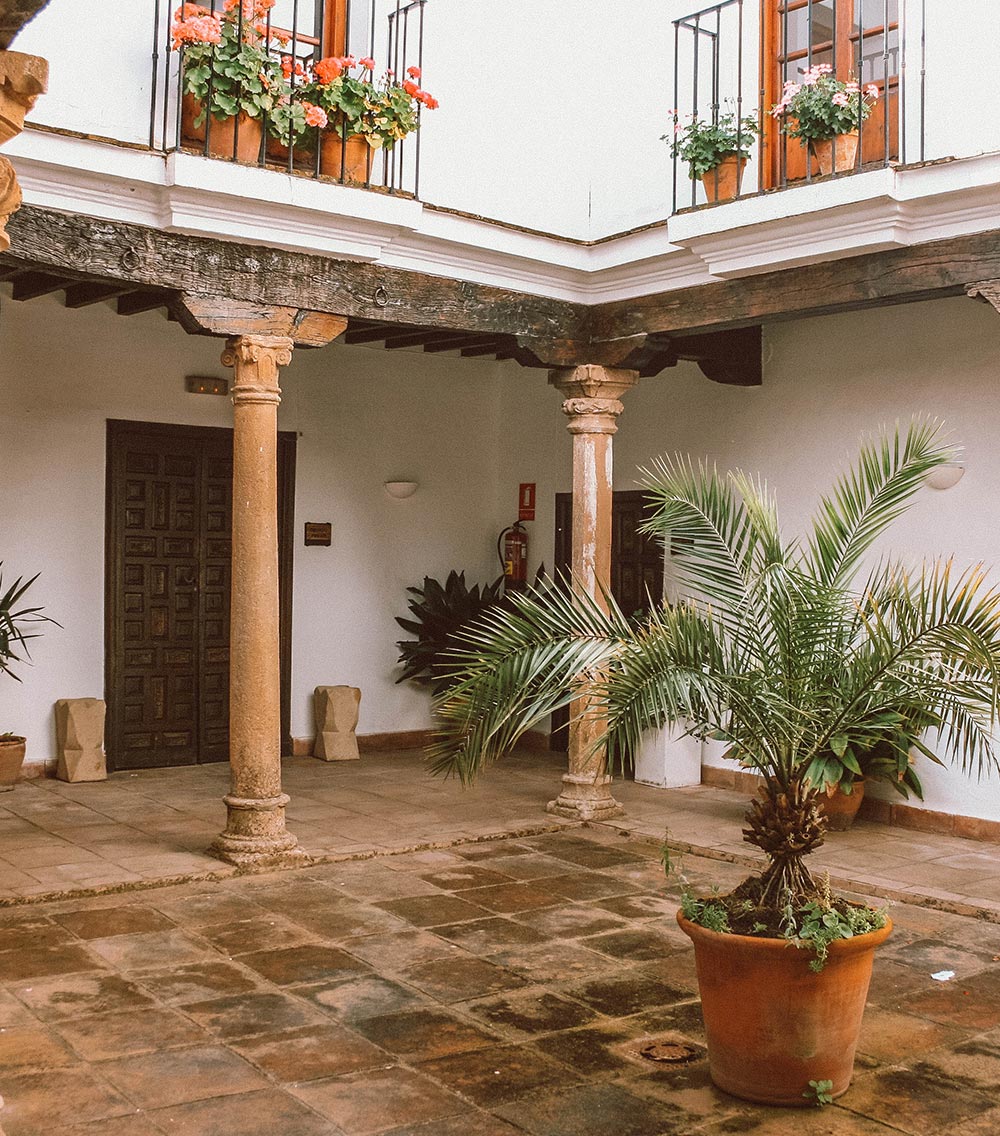
5. Ronda’s Mondragón Palace
Ronda’s Mondragón Palace, also known as Palacio de Mondragón, is a beautiful palace built in the 14th century. Legend has it that this building was the residence of King Abomelic, son of the Sultan of Morocco Abul Asan. It is also known for its impressive gardens that offer breathtaking views of the surrounding landscapes.
Explore the various rooms and courtyards, including the Arab baths and the magnificent gardens. The palace has a museum that showcases the history of Ronda including exhibits of pottery, coins, and artifacts from the Roman and Arab periods.
The Mondragon Palace houses the Ronda Municipal Museum, it is open daily and offers guided tours for visitors.
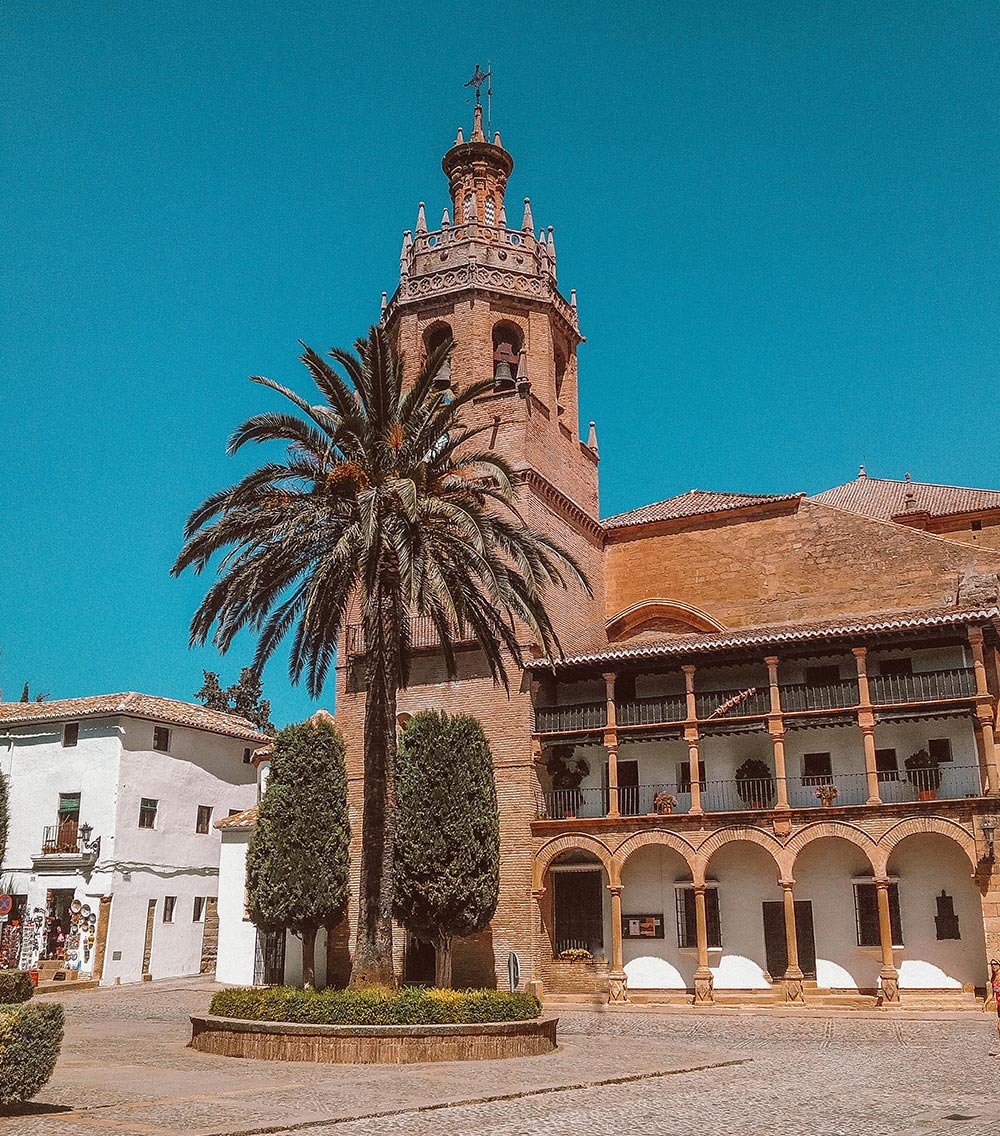
6. Duchess of Parcent Square
Duchess of Parcent Square, also known as Plaza de la Duquesa de Parcent is considered one of the most beautiful squares in the city. It is named after the Duchess of Parcent, a Spanish noblewoman who was born in Ronda and became known for her beauty and cultural patronage.
The square is surrounded by lovely white buildings, including the St Mary Major Church, with wrought-iron balconies and colorful flowerpots, creating a romantic atmosphere. Admire the statue of the duchess, which stands in the center of the square. Nearby, there are many restaurants and cafes offering delicious food and drinks.

7. The Bandit Museum
The Bandit Museum, or Museo del Bandolero, is a unique and interesting attraction in Ronda. The museum showcases the history of bandits and outlaws that roamed the area during the 19th and 20th centuries. You can learn about the different bandits that became famous in the region, their stories, and the impact they had on the local culture.
The museum is located next to Plaza Duquesa, in Calle Arminan in a historic building that used to be a prison, adding to the atmosphere of the exhibits. This strange museum is interesting and it is worth a visit if you want to learn more about the role of banditry.

8. Puerta de Almocabar and the Arab Walls
Puerta de Almocabar is one of the historic entrances to the old town of Ronda, dating back to the 13th century. The Arab walls that surround the old town were built in the 12th century during the Islamic rule of the city. They were originally designed to protect the city from the Catholic monarchs who were trying to reclaim the area. The walls are a testament to the impressive engineering and military prowess of the Moors.
Today, the walls and the Puerta de Almocabar offer a glimpse into Ronda’s rich history and provide a perfect opportunity for taking photos. You can also take a walk along the walls and enjoy the stunning views of the surrounding landscape.
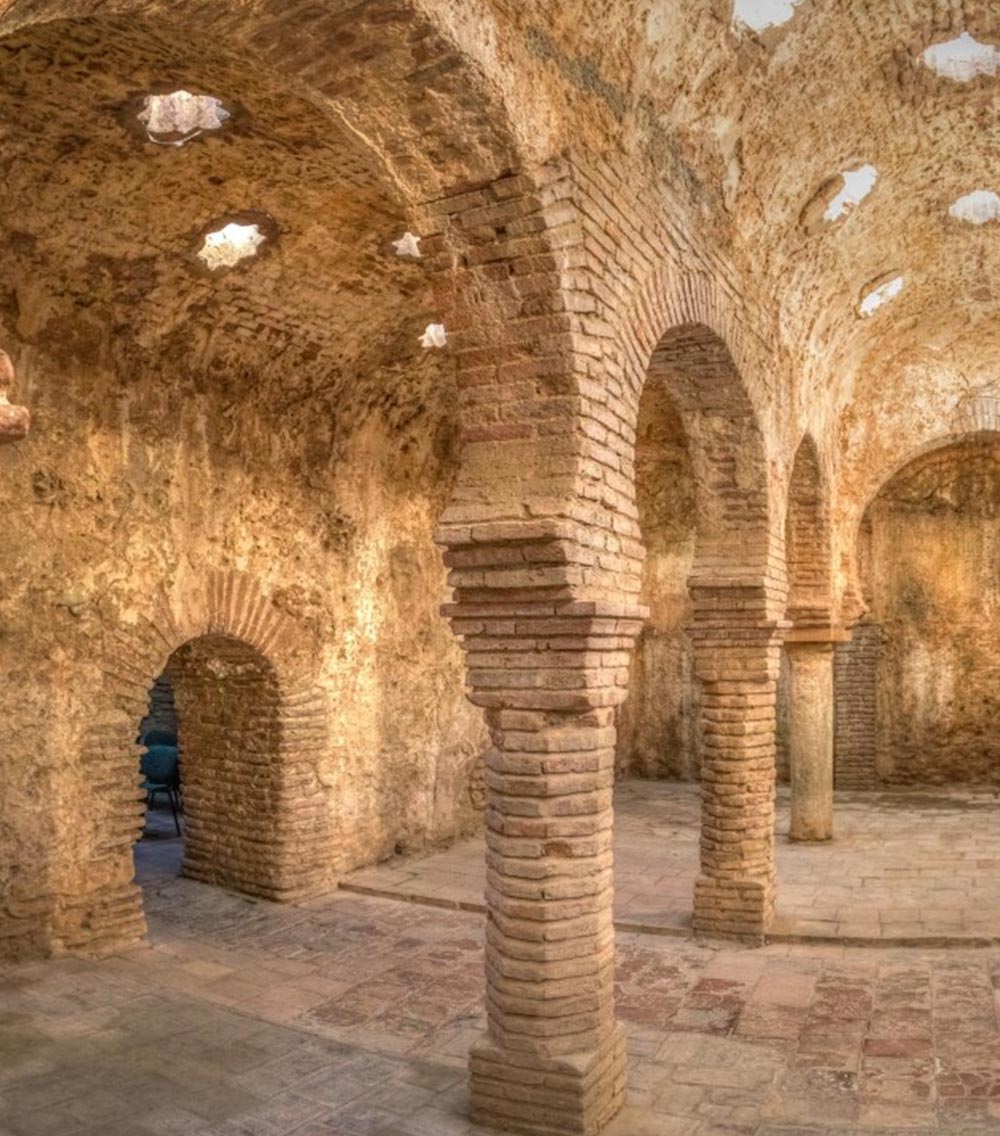
9. Ronda’s Arab Baths
Ronda’s Arab Baths, also known as Baños Arabes, is a hidden gem that reflects the city’s rich history. These 13th-century baths are the best-preserved ruins of their kind in Spain. The baths were built along the Arroyo de las Culebras (Snakes’ Stream), a source of spring water, which has a perfectly preserved water wheel from the Moorish era.
You can explore the different rooms that were once used for various purposes, including a changing room, a warm room, a hot room, and a cold room. The structure is built with brick and stone arches, creating a unique ambiance. They were used as a social center for the citizens of Ronda, as well as a place for relaxation and hygiene.
The baths are no longer in use, but the site is open to the public for visits.
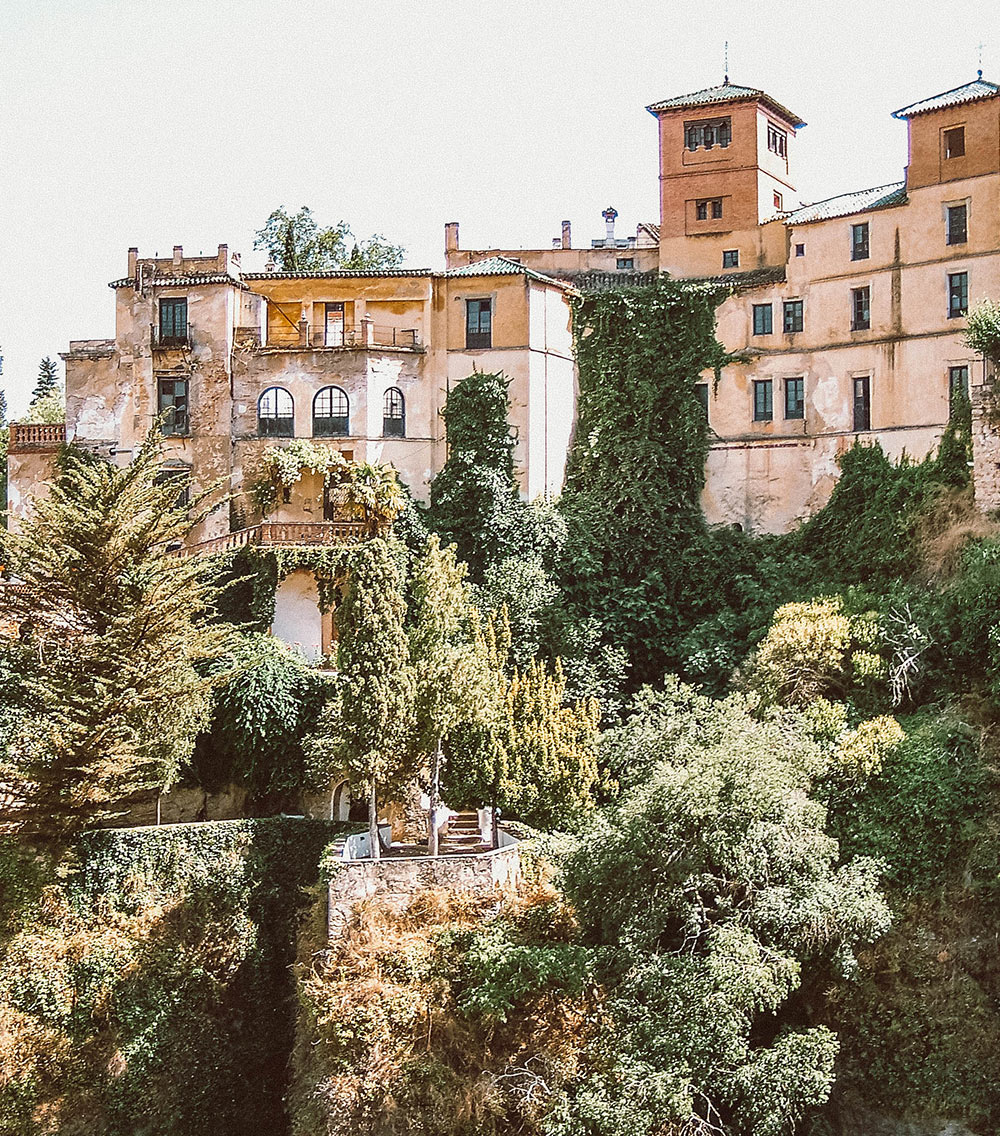
10. La Casa del Rey Moro
La Casa del Rey Moro, or the House of the Moorish King, is a historical building located in Calle Cuesta de Santo Domingo. This palace was built by the Moors in the 14th century, who installed an ingenious water pumping system. The house was originally owned by King Abbel Malik, the last king of Ronda before the Christian conquest.
Today, the house is open to visitors and provides a glimpse into Ronda’s past. You can explore the intricate gardens and the underground water mine which leads down to the Guadalevín River. You can also take a staircase cut from the rock 236 steps and which goes down 60 meters to reach a platform allowing you to have a very nice view.
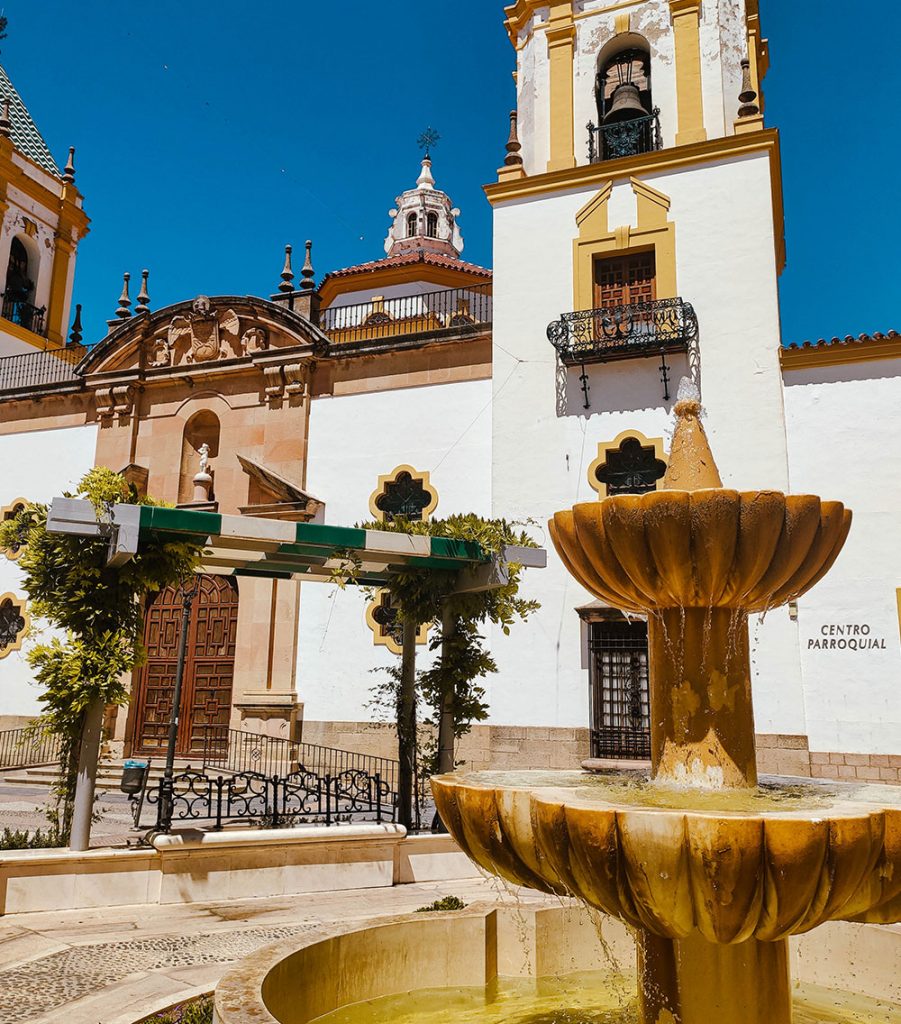
11. Plaza del Socorro
Plaza del Socorro is one of the most important and largest squares in Ronda where you can rest in any of the cafes or restaurants. A central fountain spouts water in the center, while around the sides of the square are restaurants, all with large, shaded patios. Additionally, the square is home to the Church of Our Lady of Sorrows, a beautiful Baroque-style church that dates back to the 18th century.
If you are staying the night in Ronda, we recommend you visit the square in the evening. The square transforms into a lively spot, with all the restaurants and well-lited buildings.
A small parking garage is located right under the square, and although relatively expensive, it is exceptionally well located at all the major attractions.
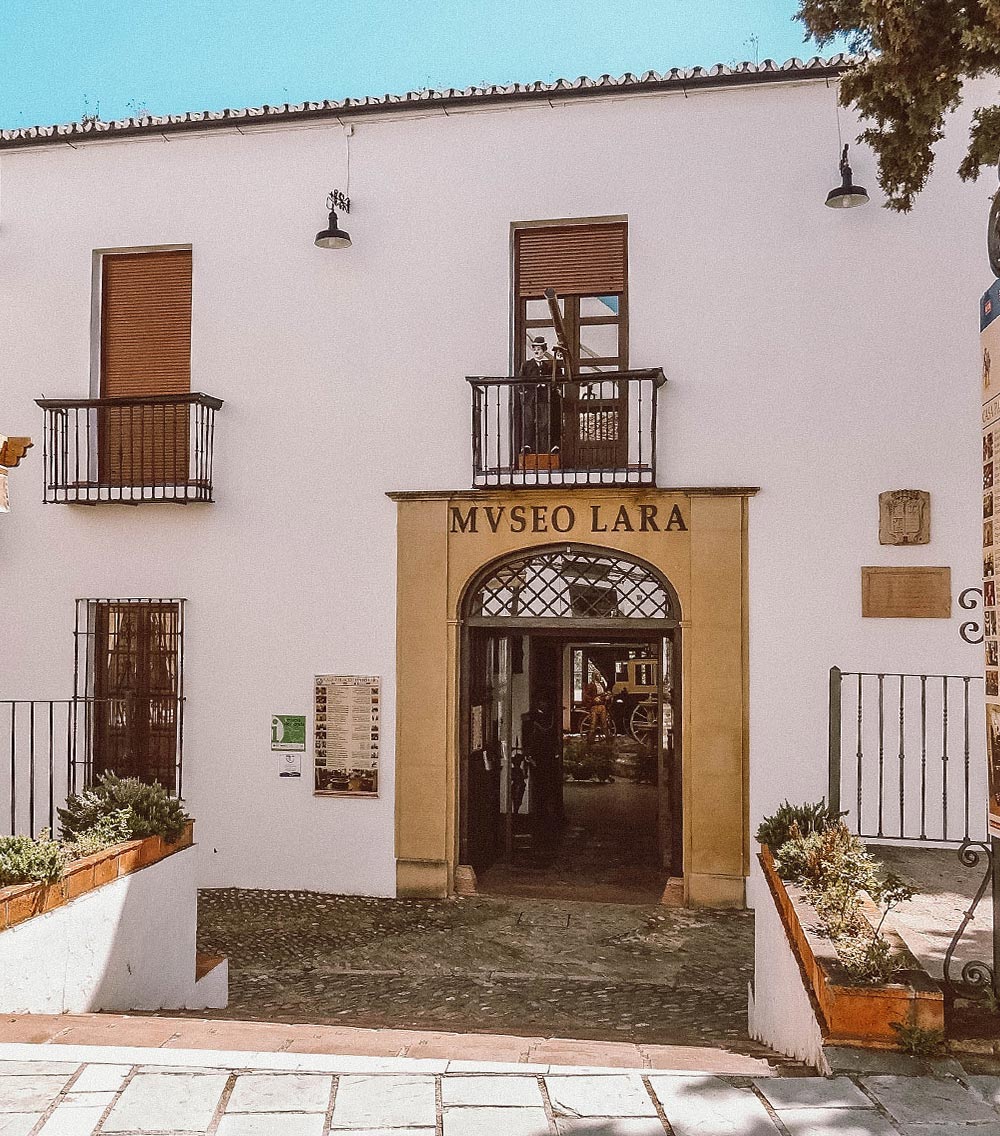
12. Arco de Felipe V
Arco de Felipe V, also known as the Puerta de Felipe V, is an arch built in the late 18th century to commemorate the visit of King Felipe V of Spain to the city. The arch is situated on one of the entrances to the old town, offering an impressive entryway into the historic district.
The architecture of the arch is a fine example of Baroque style, featuring a central arch with a keystone and two smaller arches on either side. The facade is adorned with elaborate details and sculptures, including the coat of arms of the Spanish monarchy.
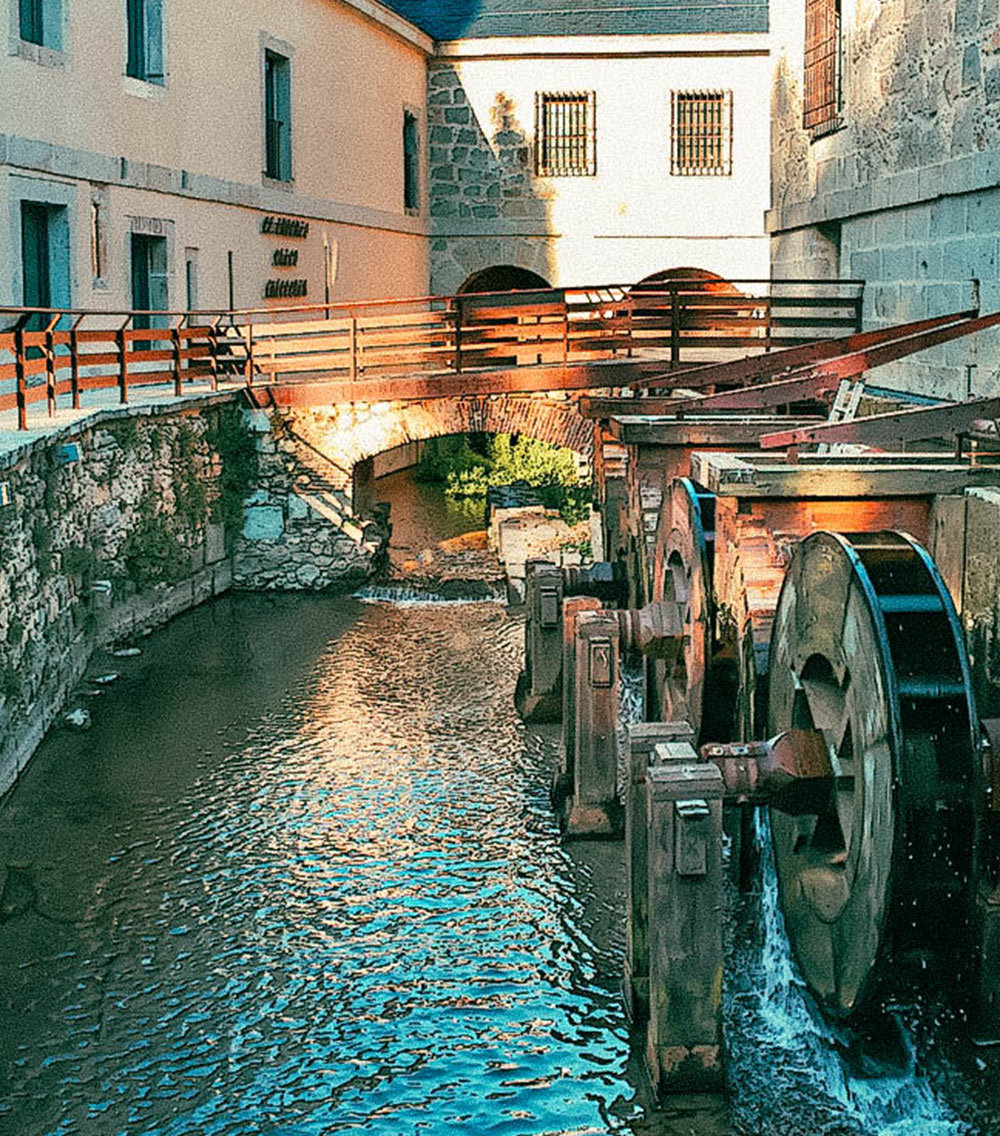
13. Museo Lara
Museo Lara is located in the Casa Palacio de los Condes de las Conquistas in the Old Town. This museum houses a vast collection of ancient and historic objects, including paintings, clocks, jewelry, coins, and more. The collection was assembled over several decades by the Lara family, and it features unique and rare pieces from various cultures and time periods.
Some of the highlights of the museum’s collection include an ancient Egyptian mummy, a 15th-century Flemish tapestry, and a gold and silver jewelry collection from the 19th century. The museum is housed in a beautiful 18th-century building, which adds to the charm of the experience.
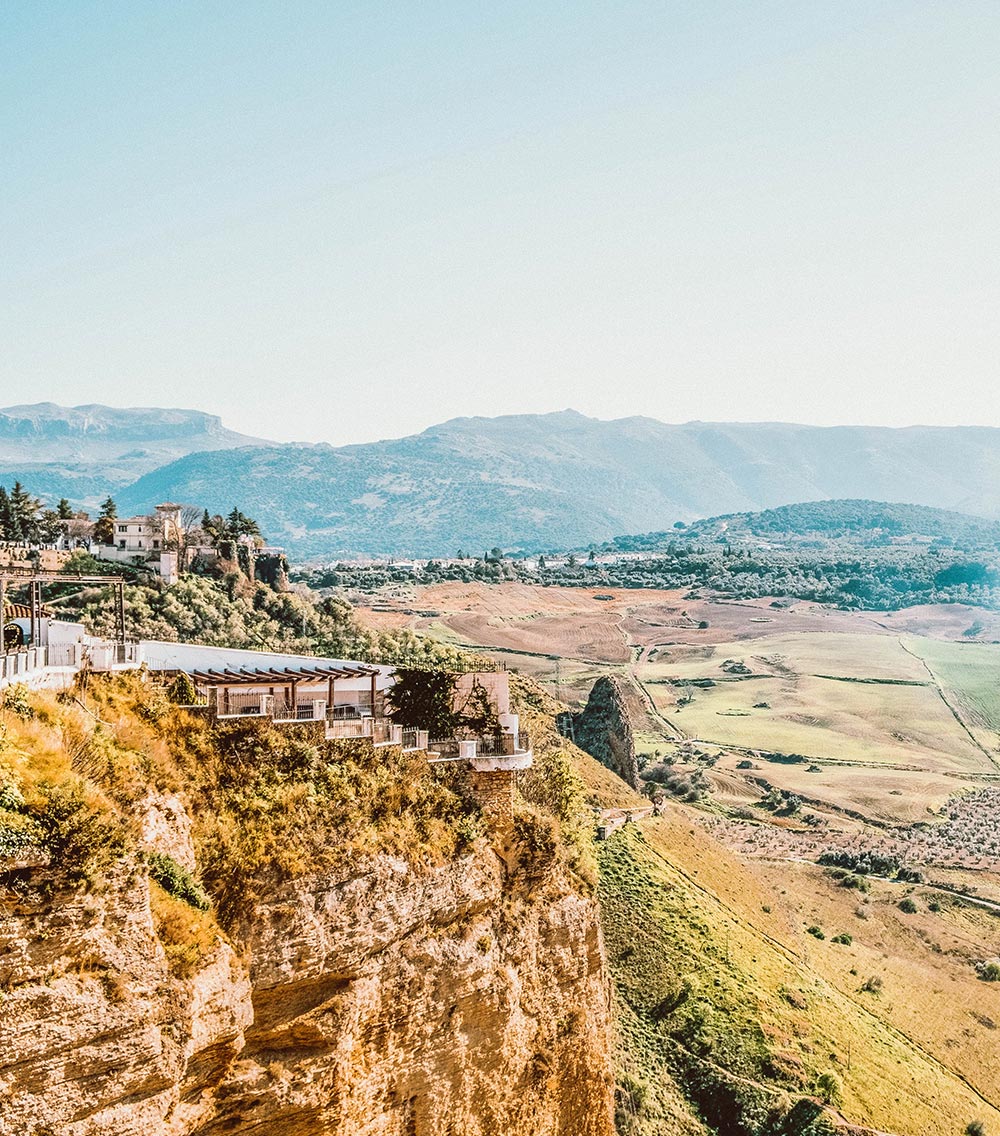
14. Admire the views from the Alameda Del Tajo
If you’re looking for panoramic views of the surrounding landscape, head to the Alameda del Tajo in Ronda. This beautiful 19th-century public park overlooks the Tajo Gorge and offers breathtaking views of the surrounding mountains and valleys.
From here, you can also catch a glimpse of the Puente Nuevo and the old town. The park features a variety of trees, flowers, and sculptures, making it a great place for a peaceful stroll or a picnic. The park is easily accessible from the old town and there are several benches and shaded areas where you can relax and take in the scenery.
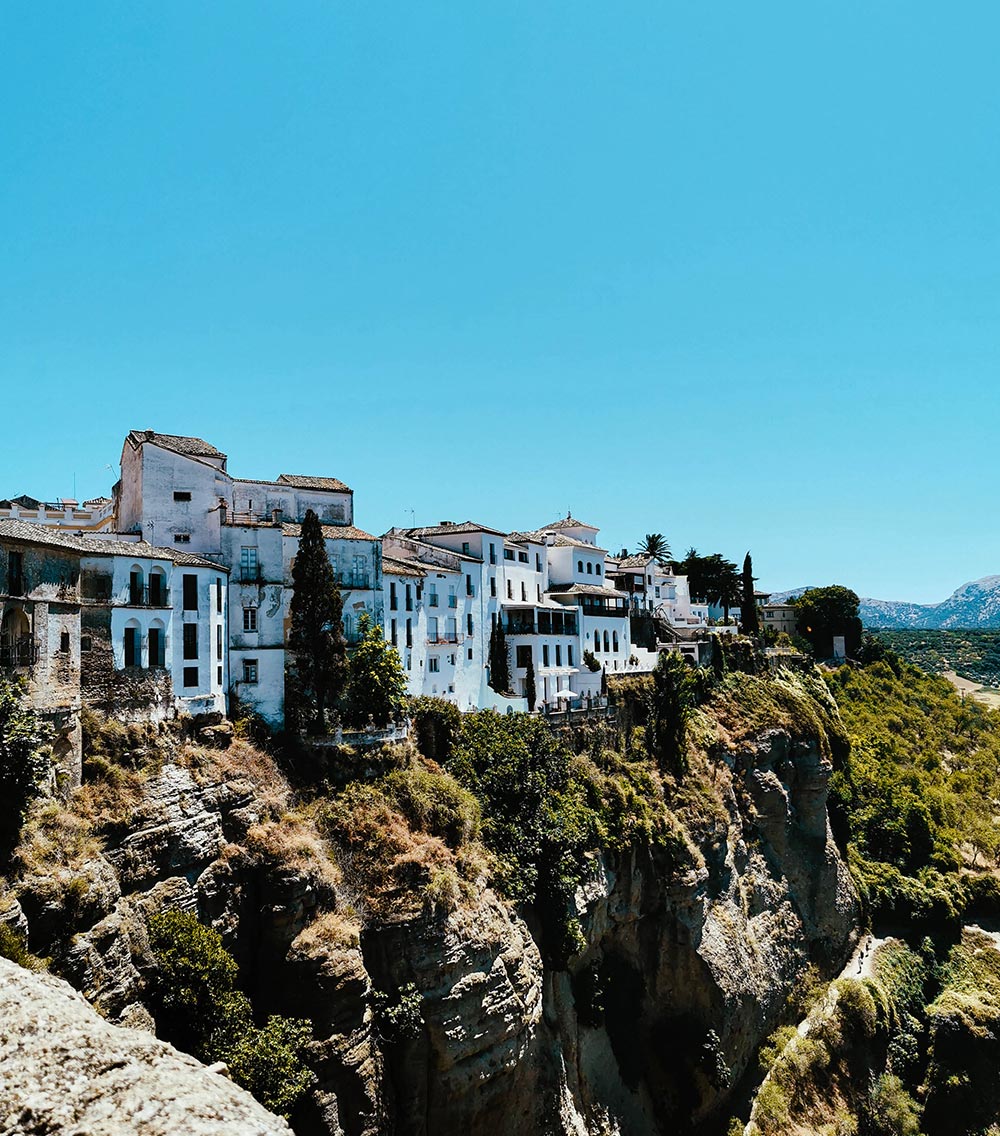
15. La Ciudad: The Old Moorish Town
La Ciudad, also known as the Old Moorish Town, is a historic district in Ronda that features narrow streets, white-washed houses, and beautiful architecture. La Cuidad has an Old World European charm combined with some of the ambiances of a medina (walled town of North Africa). This is the area where you will find most of the town’s cultural attractions.
The neighborhood was originally built by the Moors in the 8th century, and many of the buildings and structures have been preserved over the centuries. The area is perfect for a stroll, where you can also explore the Almocábar Gate, one of the original entrances to the Old Town, and the ruins of the Arab Baths. Nearby is Casa Juan Bosco, a 20th-century palace set in beautiful gardens.
Calle Armiñán houses also the Museo del Bandolero (Museum of Bandits) that we mentioned earlier.
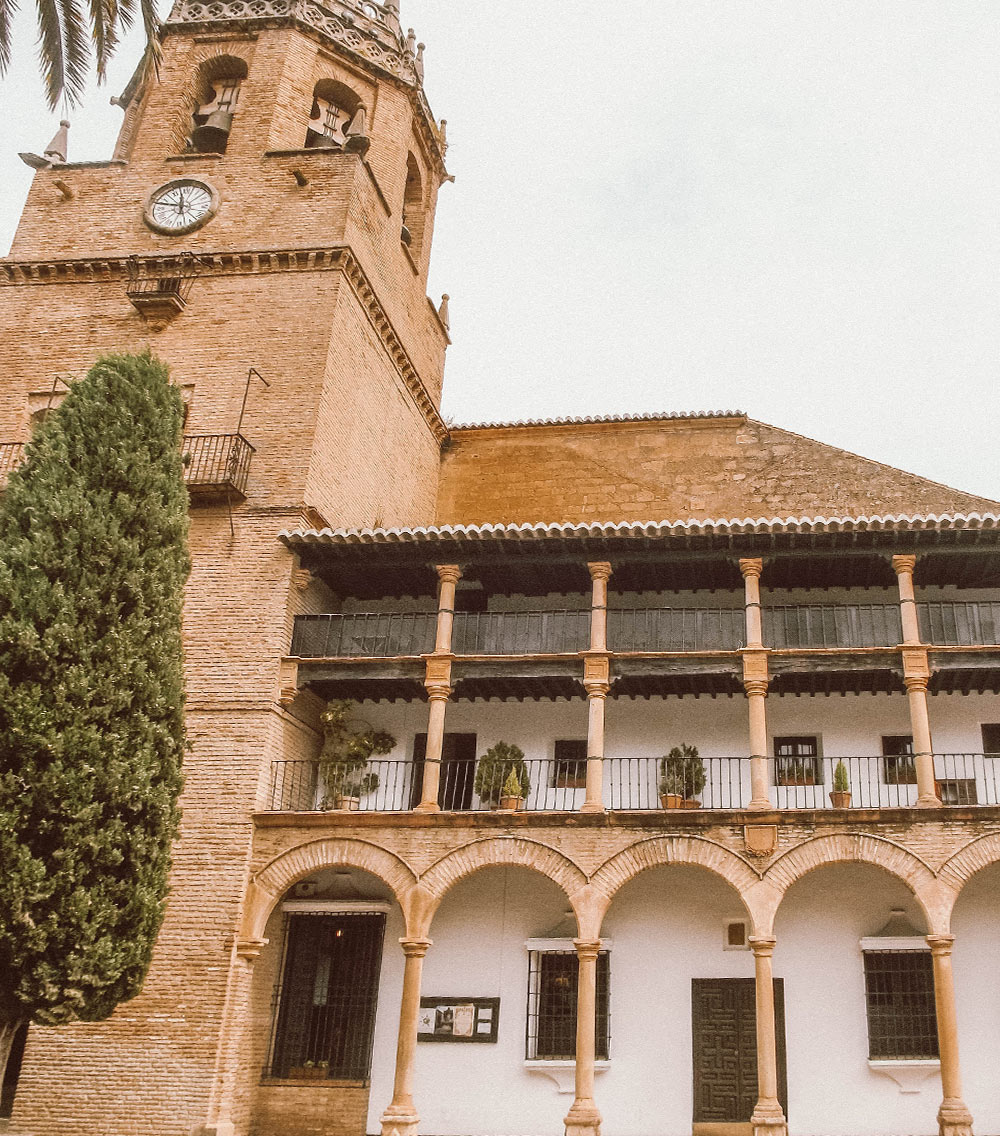
16. Iglesia de Santa María La Mayor
The Iglesia de Santa María la Mayor is located in the same square as Ronda’s Town Hall (Plaza Duquesa de Parcent), in the heart of the old town. This church dates back to the 14th century and was built on the site of a former mosque.
Admire the church’s exterior, with its towering bell tower and ornate façade, before stepping inside to witness its grand interior. The church is home to several notable works of art, including a magnificent altar and a 16th-century choir loft. You can also explore the crypt, which contains the tombs of important figures from Ronda’s history.
This church is a true gem of Ronda, and it is definitely worth taking the time to visit and admire its beauty and historical significance. The Iglesia de Santa María La Mayor is open to the public for visits every day from 10:30 am until 2 pm except Tuesday and Sunday.
17. Wineries in Ronda
Ronda is famous for its wineries, and a visit to the area would be incomplete without trying the local wine. Ronda’s wineries are located mainly in the Serrania de Ronda region, and they produce some of the finest wines in Spain. The wine culture here dates back to Roman times, and the area’s unique climate and soil make it an ideal location for wine production.
Some of the popular wineries in the area include Bodega Garcia Hidalgo, Bodega Joaquin Fernandez, and Bodega Descalzos Viejos, all of which offer guided tours and tastings. The wineries in Ronda are known for their red wines, which are made from the Tempranillo grape variety, but they also produce white and rose wines.

18. Acinipo Ruins
The Acinipo Ruins, also known as Ronda La Vieja, are located about 20 km from Ronda and offer a fascinating glimpse into the ancient Roman and pre-Roman history of the region. The ruins are situated on a hill overlooking the surrounding valley, offering stunning views of the countryside. You can explore the remains of the Roman amphitheater, which could accommodate up to 2,000 spectators, and the thermal baths, as well as the remains of the pre-Roman settlement, which date back to the 6th century BCE.
The site covers an area of 32 hectares and at its 1st-century peak and down the slope are the ruins of Acinipo’s baths, where distinct rooms such as the caldarium (hot room) and tepidarium (warm room) are visible.
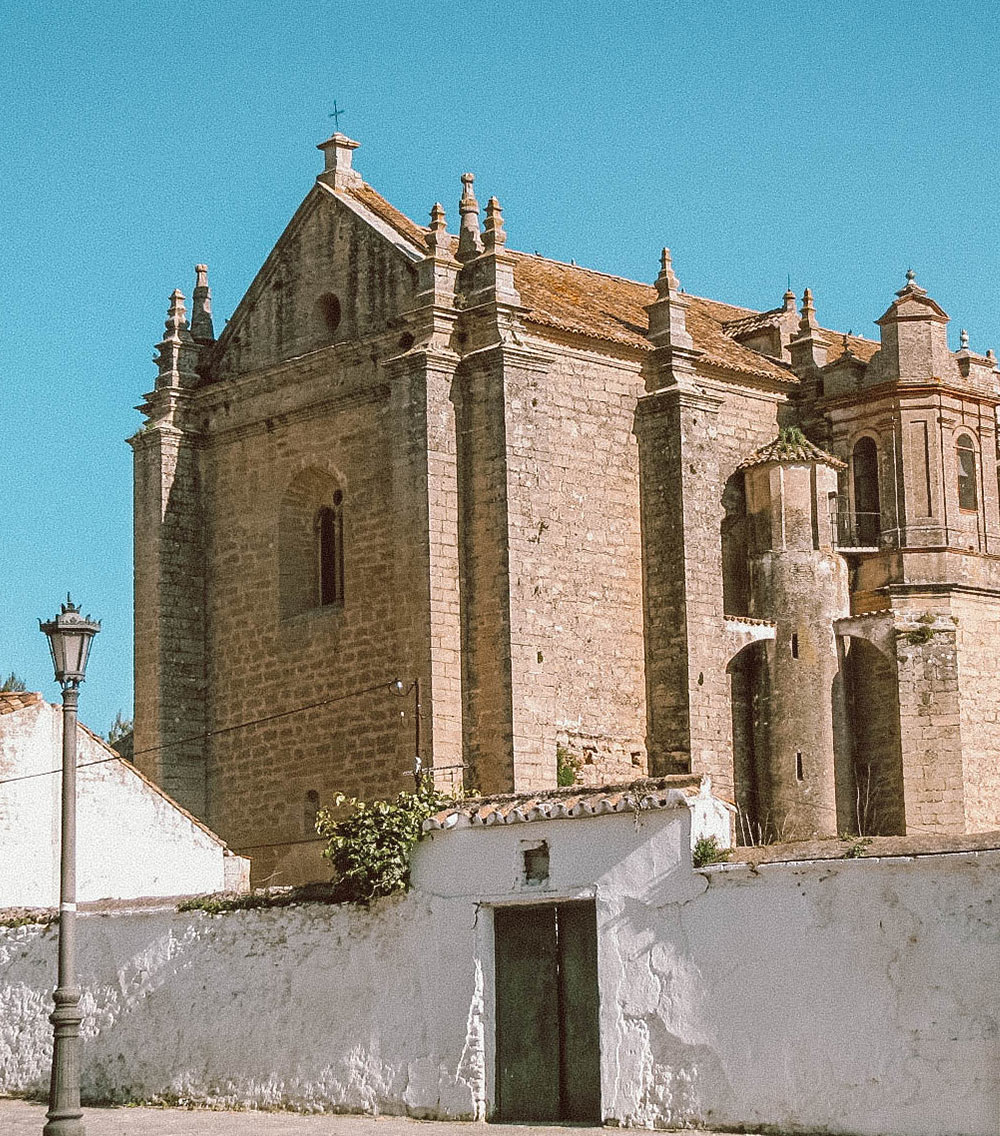
19. Iglesia del Espíritu Santo
Iglesia del Espíritu Santo is located over the Puerta de Almocábar, the first church to be built after Ronda was retaken. Built in 1505, the church features a grand façade with ornate details and intricate stonework.
Inside, you can admire the impressive altarpiece, crafted by Francisco de Goya’s brother, as well as the intricate carvings and beautiful stained glass windows. The church is also home to an impressive collection of religious artwork, including paintings and sculptures. You can also attend mass at the church or simply stop by to marvel at its beauty and historical significance.
21. Caminito del Rey

Caminito Del Rey, located about 30 minutes from Ronda, is a must-visit attraction for adventurous travelers. The Caminito del Rey hike is a 7.7 km (4.8 miles) trail that takes around 3-4 hours to complete. The trail takes you along the Gaitanes Gorge, crossing over bridges and walkways that are built into the side of the cliff. While you are walking on the trail you will be able to enjoy the views of the surrounding mountains and the El Chorro reservoir below. The walkway is 7.7 kilometers long.
Originally built in the early 20th century for workers to access the nearby hydroelectric power plant, the Caminito Del Rey was renovated in 2015 to become a safe and accessible tourist attraction. The trail has several narrow sections and a glass-bottomed section, providing an adrenaline-filled experience for thrill-seekers.
You are advised to wear comfortable shoes and bring water and snacks for the journey. The Caminito Del Rey is a popular attraction, with a maximum capacity of 1,100 visitors per day, so it’s recommended to book tickets in advance to avoid disappointment.
22. Setenil de las Botegas
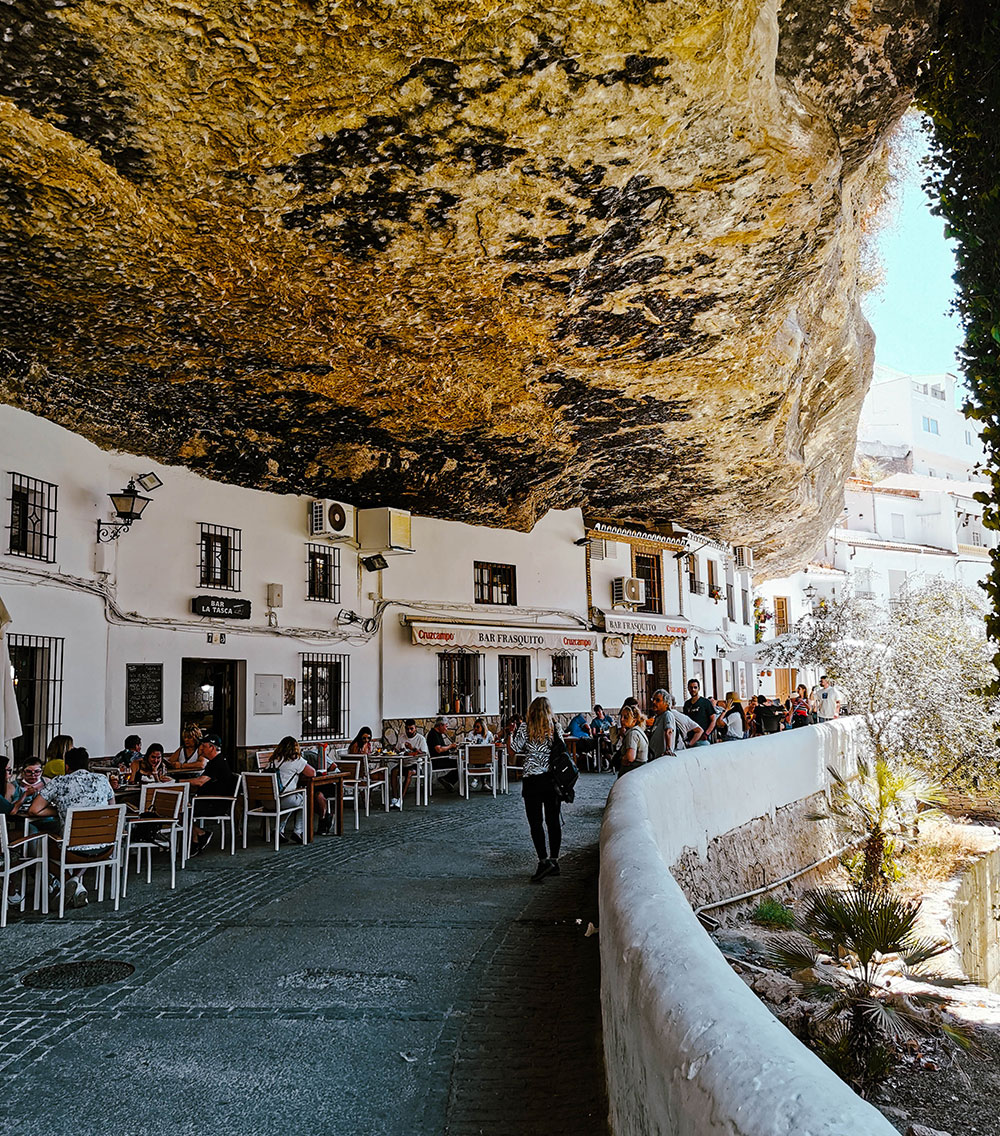
Setenil de las Bodegas is a charming village located in the province of Cádiz, Andalusia, just a short distance from Ronda. The village is unique due to its distinctive architecture, where the houses are built directly into the cliffs and rocks of the surrounding mountains.
The village is also known for its delicious local cuisine, including cured meats, olive oil, and wine. You can take a stroll through the narrow streets and enjoy the traditional Andalusian white houses with their red roofs, as well as the stunning views of the surrounding countryside. There are several restaurants and bars in the village, where travelers can try the local delicacies.
Additionally, the village is a great starting point for hiking trails in the nearby Natural Park of the Sierra de Grazalema.
Where to Stay in Ronda
Ronda is a small city, and most of the attractions are located in the old town. As a result, the best neighborhoods to stay in Ronda are those that are close to the center. Three of the best neighborhoods are El Mercadillo, San Fransisco, and Barrio de Padre Jesús, which are located just outside the old town, and it is a great option for those who want to stay close to the attractions but want to avoid crowds.
Another great neighborhood is La Ciudad, the old Moorish town, and it is located at the heart of Ronda’s historic center. This neighborhood is a great option for those who want to stay close to the main attractions, including the Puente Nuevo, the Plaza de Toros, and the Mondragón Palace.
Getting Around Ronda
the best way to explore Ronda is on foot because it is a relatively small town, and most of the main attractions are within walking distance of each other. However, there are also several options for getting around the town.
Taxis are also readily available in Ronda and are a convenient way to get around the town. There is also a local bus service that connects the different neighborhoods of Ronda.
Finally, if you are planning to explore the surrounding countryside and visit some of the nearby villages, it is recommended to rent a car. There are several car rental companies located in Ronda, and the town is well-connected to the region’s major highways.
Best Time to Visit Ronda
The best time to visit Ronda is during the spring (April to June) or fall (September to November) when the weather is mild and pleasant, and the crowds are smaller than during the summer months.
The summer months of July and August can be very hot, with temperatures often reaching over 90°F (32°C), and the city can become quite crowded with tourists. However, if you don’t mind the heat and crowds, summer can be a great time to enjoy Ronda’s outdoor activities such as hiking and exploring the city’s beautiful parks and gardens.
The winter months (December to February) can be chilly and rainy, but the city is less crowded, and prices for accommodation and activities are lower.
Frequently asked questions
is the road to ronda dangerous?
The road to Ronda can be steep and winding, with some tight turns, so it requires careful driving. However, it is a well-maintained and generally safe road, and many visitors to Ronda drive there without incident. It is important to follow the rules of the road and drive at a safe speed, particularly on the more challenging sections of the road.
Additionally, it is recommended to check weather conditions and road closures before driving to Ronda, particularly during the rainy season.
How many days in ronda?
In our opinion, one day is enough to see the major attractions in Ronda. If you want fully experience the town and its surroundings, go hiking or wine tasting, and visit nearby towns and attractions, we suggest staying for 3 to 4 days.
How was ronda gorge formed?
Ronda Gorge was formed over millions of years by the erosion of the Guadalevín River as it flowed through the limestone mountains in the area. The river gradually cut deeper and deeper into the rock, creating the spectacular gorge we see today. The limestone rock of the gorge is riddled with caves and underground rivers, and the porous nature of the rock allows the water to create stunning formations both above and below ground.
The gorge has been an important geographical feature in the area for thousands of years and has played a significant role in the development of Ronda and the surrounding towns. Today, it is a popular tourist destination, attracting visitors from all over the world who come to marvel at its natural beauty and the engineering feats that have been built to navigate its steep cliffs.
How do you get to the bottom of Ronda Gorge?
To get to the bottom of Ronda Gorge, also known as El Tajo de Ronda, you can take the path known as La Cuesta de las Imágenes or the “Steps of the Immaculate Conception.” The steps begin at the Puente Nuevo and descend 90 meters down the cliff face to the base of the gorge. The steps offer a stunning view of the gorge and the surrounding landscape, but the descent can be steep and challenging, so it’s important to wear comfortable shoes and take caution.
It’s also possible to reach the bottom of the gorge by car or bike through a winding road that leads to a parking area near the base of the Puente Nuevo. However, it’s important to note that the road is narrow and can be difficult to navigate.






No Comments